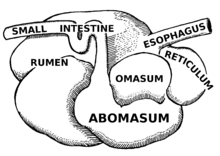Abomasum

The abomasum, also known as the maw, creation.
The word abomasum (ab- "away from" + Gaulish language.
Function
The abomasum's normal anatomical location is along the ventral midline. It is a
microbial and dietary protein, preparing these protein sources for further digestion and absorption in the small intestine. The abomasum is lined with glands to release hydrochloric acid
and digestive enzymes needed to break down food. It is very similar to the nonruminant stomach.
Pathology
Dairy cattle on high production diets are susceptible to a number of pathologies, most commonly after calving. A gas-filled abomasum can move into an abnormal location and become
displaced. If the abomasum displaces to the right, it is at risk of torsion. A displaced abomasum will cause cows to present all or some of the following signs: loss of appetite, decrease rumen contractions, decrease cud-chewing, and drop in milk production. While a displaced abomasum is not immediately life-threatening, veterinary care is required for surgical correction. Milder cases can be corrected by rolling the cow over or forcing her to run up a steep hill.[2] Abomasitis
is a relatively rare, but serious, disease of the abomasum whose causes are currently unknown.
As food
The abomasum is used to make the Makchang gui. Another dish made with the abomasum is the Persian Sirabi-Shirdan (borrowed in Turkey as Şırdan). Chusta (literally abomasum) is a famous dish in Bihar, India.
See also
- Giving of the foreleg, cheeks and abomasum
- Methanogens in digestive tract of ruminants
References
- ^ a b c The Chambers Dictionary, Ninth Edition, Chambers Harrap Publishers, 2003 Archived October 29, 2006, at the Wayback Machine
- ^ DN: Displaced Abomasum
